Sherry and I were having our weekly staff meeting at Barnes & Noble and as usual, I was highly distracted by the display table. Being that it’s October, the books were all about Halloween – one of my favorites! I began pulling books to look at (sorry Barnes & Noble employee who had to put them all back when I was done) and began to flip and peruse the new selections. Shivery Shades of Halloween was one of the last ones I looked through, and to be honest, I didn’t have high expectations. However, I was completely wrong and it was such a good thing that we found this one last because if it had been first, Sherry and I would have accomplished NOTHING!
Why I Finished It:
It’s brilliant! Yes, it is a book that is probably designed for preschoolers and primary students, but it is impressively complex! The text is filled with incredibly high vocabulary, which is well beyond the knowledge of the children to which it would naturally appeal. The complex vocabulary is not difficult though, because the of the rhymes and the pictures that support the text! Each page of this brilliant book gives a rhyme vividly portraying a different aspect of Halloween through description of a color and the things about the holiday that are that color. Not only did Sherry and I want to finish the book, we went through it about four times discussing the endless possibilities of this book.
Who I Would Give It To:
Teachers, parents, students, everyone! I read it aloud to my son’s second grade class, somewhat for me and somewhat for a kid’s perspective. They LOVED it! Some of what we did is below in lesson ideas.
Integration Ideas:
Building Background Knowledge (Schema)
In the second grade class, I began by asking the students what colors they thought about when I said Halloween. In my own class, I would begin a chart. Once they say a color, ask them what in Halloween makes them think of that color. This is a great way to begin thinking about the holiday, color association, and specific words and “things” that are thought about when it comes to Halloween. As you read the story, acknowledge what someone has already said and continue to add to the chart.
For older students, Sherry and I thought it would be great to compare and contrast the colors in different seasons. If green for Halloween is “slimy-grimy, queasy-peasy, …” how would you describe green for Christmas? Students can write their own descriptions for other holidays.
Vocabulary, Description, Visualization and Writing
I guarantee a smile as you read this playful, rhyming text. But, truth is, the vocabulary is challenging. On a second read, pull out the words and discuss them with the students.
Try a vocabulary App Smash! Have students make connections to their own life. What else is vile or clammy? What great describing words!
Ask students for synonyms to the words used in the book. Which word paints a better picture in the reader’s mind?
How do the words and description in the story excite the senses? Choose one word and write it on a chart; i.e. vile. Underneath have students explain what the word vile makes them see, smell, taste, touch, and hear. This is a great time, on a second read, to have students close their eyes as you read one line at a time. Have them discuss what they sensed. What words brought that image to their heads? How can they emulate this great description in their own writing?
Colors and Technology
Technology has made it possible to do really cool things with colors and images! I (Sherry) recently ran across this site that takes images and creates a color palette around them: http://design-seeds.com/ The site is intended to inspire, mostly for crafts, remodeling projects, weddings, etc., but the images can definitely inspire writing as well! Each palette has a distinct mood and tone, so let students choose a color palette and try writing about each of the colors, keeping the mood/tone of the accompanying image in mind.
You can also try taking a favorite Halloween image and distilling it into your own color palette with one of these tools:
Once you’ve created a visual, you can smash it into another app or tool and use it as a background for students’ writing.
- Haiku Deck – a presentation tool that focuses on images (you can upload your own) and minimal words
- Canva – great tool for creating beautiful visuals using your own images, lots of great fonts and layouts to choose from
Creativity with Colors and Shapes
Colors evoke mood and tone depending on the context, but shapes can do the same thing (Molly Bang has a phenomenal book called Picture This that details how structural elements affect our emotions). Using the Museum of Modern Art’s App – MOMA Lab – use the shapes and colors to create an image that represents Halloween to you. Of course, follow up the creation of the image with some descriptive writing!
(Don’t judge my pumpkin – I’m definitely not an artist…)
You could also combine shapes and lines to make your own monster (one of the inspiration ideas from the app!).
Magnetic Poetry
Use PicLits to have students write their own poems or sentences based on a picture.

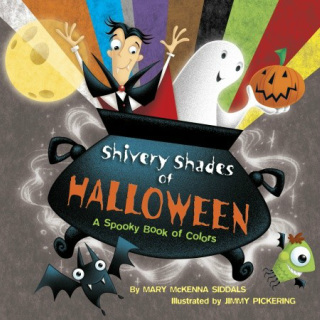
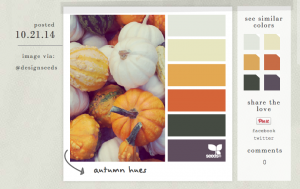
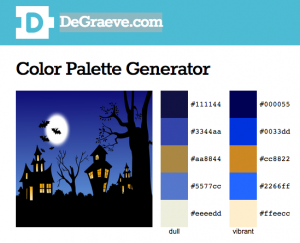
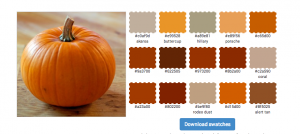
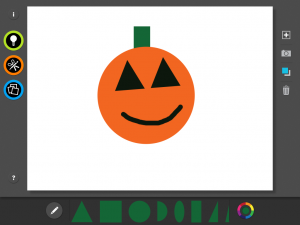
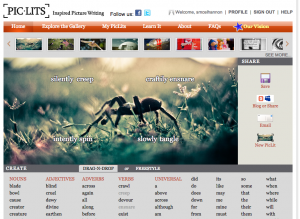





What faBOOless ideas for exploring the full spectrum of the book! Many FANGkS, Jessica and Sherry, for brewing up these SPOOKtacular suggestions! I look forward to sharing them on the SHIVERY SHADES OF HALLOWEEN Facebook page, as well as in the teaching resources section on my website. BOOyah!
Hi, I came across your blog when searching for a cover image for the book, “Shivery Shades of Halloween” for my blog. I am a library media specialist and I used this book today with third grade. I had the students visualize a color that they thought represented Halloween first as well and then provide the evidence to support their visualization. I also had them write their own color poetry focusing on similes and alteration. I like your blog because it combines literacy and technology–two of my favorite things!
Thank you for sharing! I love the writing ideas and I know our readers will as well. I have added your blog to my feedly and look forward to hearing more about the Dayton Media Center.
*aliteration
I love your idea for Design Seeds. As an avid crafter and DIYselfie, I too use came across this site when working on a project, but as a K-5 GT teacher I quickly realized that I could be used by my students to focus their ideas and classroom projects. Visuals and colors convey meaning and if we can get kids thinking and expressing themselves in visuals and colors it only supports activities that require them to express them selves in written or oral language. I think first in feelings and emotions, then in color and visuals, and then finally in words and language; and I credit modeling this meta-cognative process for students for the success I’ve experienced in my classroom.